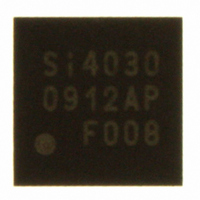SI4030-A0-FM Silicon Laboratories Inc, SI4030-A0-FM Datasheet - Page 28

SI4030-A0-FM
Manufacturer Part Number
SI4030-A0-FM
Description
IC TX ISM 930MHZ 3.6V 20-QFN
Manufacturer
Silicon Laboratories Inc
Type
ISM Transmitterr
Specifications of SI4030-A0-FM
Package / Case
20-QFN
Frequency
240MHz ~ 930MHz
Modulation Or Protocol
FSK, GFSK, OOK
Data Rate - Maximum
128kbps
Power - Output
20dBm (100mW)
Current - Transmitting
28mA
Data Interface
PCB, Surface Mount
Antenna Connector
PCB, Surface Mount
Voltage - Supply
1.8 V ~ 3.6 V
Operating Temperature
-40°C ~ 85°C
Operating Frequency
240 MHz to 960 MHz
Maximum Operating Temperature
+ 85 C
Mounting Style
SMD/SMT
Supply Current
100 nA
Supply Voltage (max)
3.6 V
Supply Voltage (min)
1.8 V
Lead Free Status / RoHS Status
Lead free / RoHS Compliant
Features
-
Applications
-
Memory Size
-
Lead Free Status / RoHS Status
Lead free / RoHS Compliant, Lead free / RoHS Compliant
Other names
336-1624-5
Available stocks
Company
Part Number
Manufacturer
Quantity
Price
Company:
Part Number:
SI4030-A0-FM
Manufacturer:
SILICON
Quantity:
120
Part Number:
SI4030-A0-FM
Manufacturer:
SILICONLABS/èٹ¯ç§‘
Quantity:
20 000
Si4330-B1
4. Modulation Options
4.1. FIFO Mode
In FIFO mode, the receive data is stored in integrated FIFO register memory. The FIFOs are accessed via
"Register 7Fh. FIFO Access," and are most efficiently accessed with burst read/write operation as discussed in
"3.1. Serial Peripheral Interface (SPI)" on page 16.
In RX mode, only the bytes of the received packet structure that are considered to be "data bytes" are stored in
FIFO memory. Which bytes of the received packet are considered "data bytes" is determined by the Automatic
Packet Handler (if enabled), in conjunction with the Packet Handler Registers (see Table 12 on page 35). If the
Automatic Packet Handler is disabled, all bytes following the Sync word are considered data bytes and are stored
in FIFO memory. Thus, even if Automatic Packet Handling operation is not desired, the preamble detection
threshold and Sync word still need to be programmed so that the RX Modem knows when to start filling data into
the FIFO. When the FIFO is being used in RX mode, all of the received data may still be observed directly (in real-
time) by properly programming a GPIO pin as the RXDATA output pin; this can be quite useful during application
development.
When in FIFO mode, the chip will automatically exit the RX State when either the ipksent or ipkvalid interrupt
occurs. The chip will return to any of the other states based on the settings in "Register 07h. Operating Mode and
Function Control 1."
In RX mode, the rxon bit will be cleared if ipkvalid occurs and the rxmpk bit (RX Multi-Packet bit, SPI Register 08h
bit [4]) is not set. When the rxmpk bit is set, the part will not exit the RX state after successfully receiving a packet,
but will remain in RX mode. The microcontroller will need to decide on the appropriate subsequent action,
depending upon information such as an interrupt generated by CRC, packet valid, or preamble detect.
28
Rev 1.0












